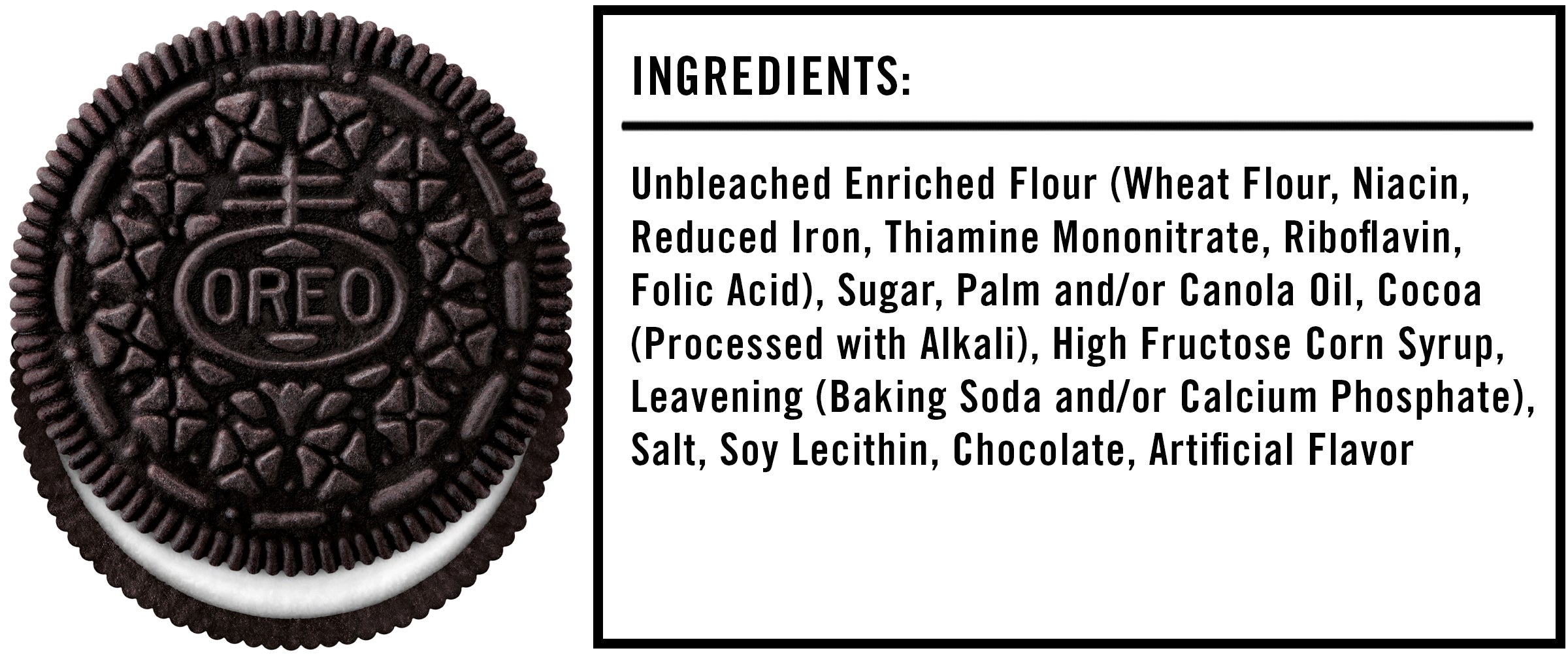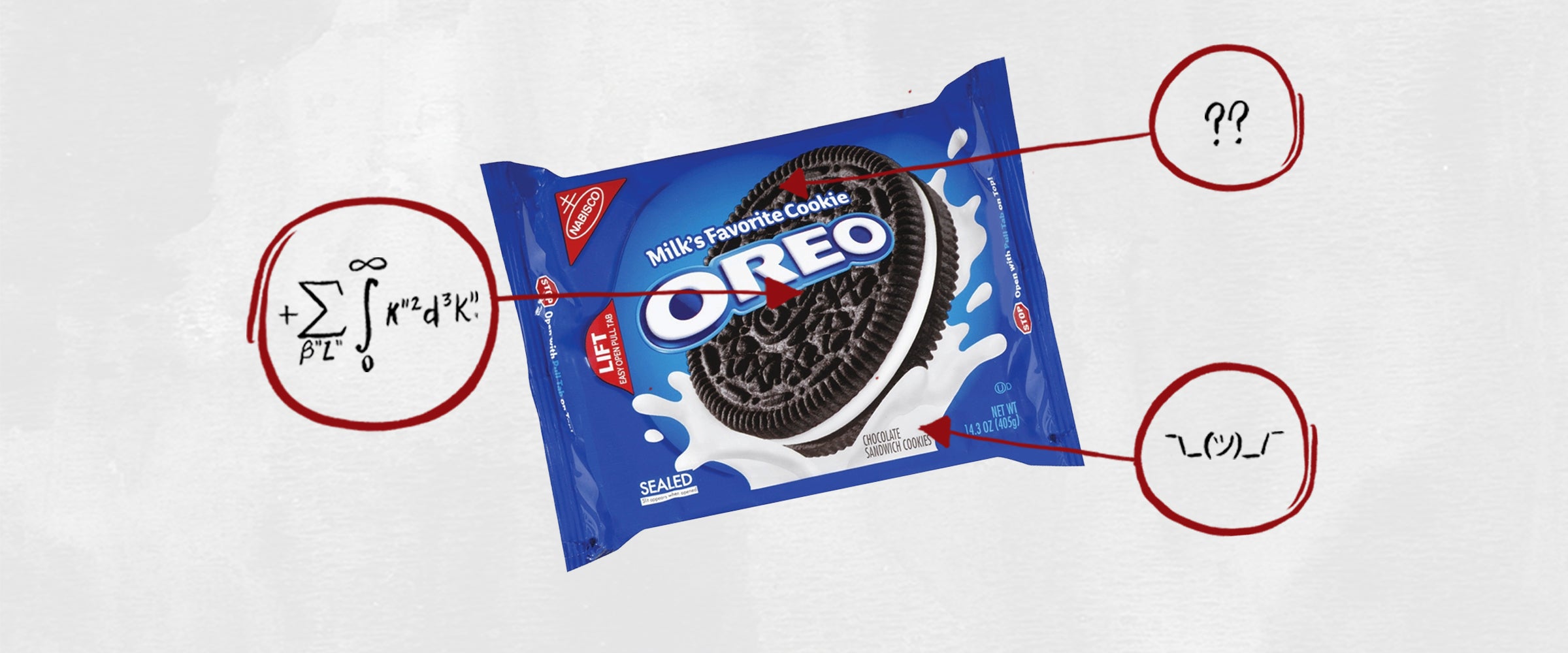We’re often told that you should never eat anything (or put anything on your body) if you don’t recognize everything on the ingredients list. But since most of us have no idea what xanthan gum or potassium benzoate are — or more importantly, what they’re doing to our bodies — we’re decoding the ingredients in the many things Americans put in (and on, or near) themselves with the help of an expert.
This edition: Oreos, which are made from 10 separate ingredients (some of which have ingredients lists of their own) that we’ve broken down in the exact order they appear online.
First, though, I want to talk Oreo variations, of which there are many. There are, of course, the legendary Double Stuf variety, which have the exact same ingredients as the regular ones. The nutritional content is also comparable, and if that sounds like some kind of bullshit trickery, that’s because it is: Double Stuf Oreos have a smaller serving size (two cookies instead of three).
Then there are the more colorful adaptations, like Halloween Oreos or Winter Oreos, which are essentially just Double Stuf Oreos with added artificial colors. That coloring might sound extra bad, but physician and biochemist Cate Shanahan, author of Deep Nutrition: Why Your Genes Need Traditional Food, previously reassured us that artificial colors are added to foods in negligible amounts, and therefore, they’re virtually harmless.
Finally, there are the gag-worthy, flavor-diverse mutations, like Mint Oreos or Strawberries and Creme Oreos. Again, these might as well be regular Double Stuf Oreos apart from the extra artificial flavor (which we’ll get into more below).
Now that we’re well-versed in Oreo diversification, let’s check in on the ingredients in your standard black-and-white sugar sandwich.

The Ingredients
1) Unbleached Enriched Flour (Wheat Flour, Niacin, Reduced Iron, Thiamine Mononitrate, Riboflavin, Folic Acid): While bleached enriched flour can be quite the devious ingredient, something we explained in-depth during our analysis of the many, many ingredients in a McDonald’s Big Mac, unbleached enriched flour actually isn’t so bad. In fact, it boasts an assortment of vitamins and minerals, including riboflavin, which helps the body turn food into energy, and niacin, which might have the capacity to lower cholesterol, ease arthritis and even boost brain function. Still, nutritionists generally agree that unadulterated whole-wheat flour is the healthier choice.
2) Sugar: One serving size (three Oreos, which, lol) contains 14 grams of sugar, which can absolutely add up if you’re anything like my esteemed colleague Quinn Myers, who recently went on a panic-induced Oreo binge when his fiancée left him home alone for, like, two days. Just so you know, the American Heart Association recommends men consume no more than 36 grams (about eight Oreos) and women consume no more than 25 grams (about five Oreos) of added sugar a day, and that doesn’t include sugar found naturally in foods like fruits and vegetables.
3) Palm and/or Canola Oil: Shanahan previously told me that consuming too much vegetable oil — which is easy to do, considering she says roughly 45 percent of the average American’s calories come from refined oils — has serious repercussions, like fatty liver disease, insulin resistance and migraines. While it’s near impossible to eliminate vegetable oil from your diet altogether — major contributors include processed foods, fried foods, frozen pizzas, cakes, cookies, margarines and coffee creamers — it’s best consumed in moderation. Also, as we discovered during our ranking of cooking oils by how unhealthy they are, palm oil is one of the least healthy oils available and absolutely mind-bogglingly terrible for the environment.
4) Cocoa (Processed with Alkali): Also known as Dutch process cocoa powder, this has a more earthy flavor than your average cocoa powder. “Consuming large amounts of alkalized cocoa powder is possibly unsafe due to the caffeine content,” Dagan Xavier, ingredient expert and co-founder of Label Insight, warned during our exploration of the ingredients in chocolate Muscle Milk. “This can cause problems for pregnant women, where the caffeine could cross the placenta and enter the bloodstream of the fetus.” Cocoa may also trigger migraines in those susceptible to them.
5) High Fructose Corn Syrup: High fructose corn syrup is corn syrup that’s had some of its glucose converted to fructose enzymatically. It’s a commonly-used sweetener, and has been linked to obesity and diabetes by many, many studies. So, if possible, you want to avoid foods and drinks containing it.
6) Leavening (Baking Soda and/or Calcium Phosphate): Baking soda is often used as a leavening agent, helping the dough rise and become porous by increasing the surface area. The same can, more or less, be said about calcium phosphate.
7) Salt: This boosts flavor.
8) Soy Lecithin: Soy lecithin is a component of fat found in, you guessed it, soy. It’s typically added to food products as an emulsifier, which means it helps the numerous ingredients found in these cookies mix together. In some cases, soy lecithin can also help foods stay fresh while they sit on the shelves.
9) Chocolate: You already know this one, and if you don’t, c’mon, bruh. What you might not know, though, is that pure chocolate — not that commercial Hershey’s bullshit, which is chock-full of sugar, fat and calories — might actually be kinda healthy. That’s because the plain stuff is mostly made up of cacao, and as one large study suggests, flavonoids (plant pigments) found in cacao might reduce your risk of developing heart disease. Of course, chocolate containing enough cacao (and flavonoids) to be considered healthy would be extremely bitter and perhaps even unpalatable due to the lack of added sugar, so saying the chocolate in Oreos is healthy is almost certainly a stretch. But hey, let’s throw Quinn a bone here, huh?
10) Artificial Flavor: Artificial flavors are chemical compounds created in a lab that mimic a natural flavor in some way. While that may sound unhealthy, as Shanahan told us during our exploration of all 26 ingredients in nacho-flavored Doritos, these flavorings are added in such small quantities that they shouldn’t cause you any harm. As for what this flavor is, we honestly have no real way to find out (unless you work at Oreo, in which case, send me an email or something).
The Takeaway
There’s really nothing redeemable about Oreos, at least nutritionally speaking: They’re basically little sugar bombs. Then again, these are fucking cookies, so I can’t say I didn’t see that coming. All in all, try to do the opposite of what Quinn did, and eat your Oreos in moderation. Or, y’know, not at all.

